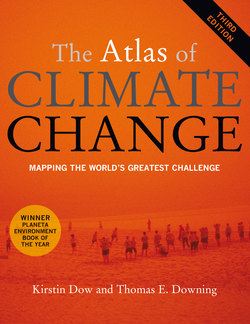Читать книгу The Atlas of Climate Change - Professor Kirstin Dow - Страница 11
На сайте Литреса книга снята с продажи.
ОглавлениеThe year 2010 may well be seen with hindsight as pivotal. It started badly, with the detritus of the Copenhagen Conference of Parties, and chaos around the future of international negotiations. Then, a series of climate extremes rekindled attention. The floods in Australia, China, and Pakistan left unforgettable images of inundation. The Chinese and Russian droughts were of a staggering scale. As we write, another crisis in the Horn of Africa is looming, recalling images of the 1970s famines. There were new entries in the league tables for extreme events, where Bangladesh and the USA dominated headlines. And budget crises continued to remind us of global economic volatility. Mostly behind the scenes, the international negotiations reconvened, making progress in Cancún. Trust in the process was restored to some extent, if not full confidence in reaching final agreements. By 2011, the Arab Spring captured our imaginations with its realignment of global politics. Attention to the future of the planet is widespread as we near the 20th anniversary of the original Earth Summit in Rio (Rio+20) – another pivotal moment and touchstone for reflection. In this Atlas of Climate Change, each double-page spread introduces central issues in current debates about the physical processes, likely impacts, and adequate responses. We noted in the introduction to the first edition some of our motivation: After listening to shrill warnings of catastrophe, dismissive statements from skeptics, decades of calls for more research, incomplete stories of the complexities of negotiations, and confusion over the level of consensus in scientific understanding, we sought to provide a resource to help people make that initial step into understanding the core issues of climate change. This third edition updates and expands upon the climate story, from increasingly common signs of change and the undisputed basics of the science, through the panoply of drivers and consequences, finishing with the status of international action and personal and public commitments to solutions. Many of the pieces of the puzzle in this story have been known for some time. Increasingly the pieces are illuminating details of the big picture. In this introduction we reflect on what we have seen and learned since 2005, when we began the first edition. There have been substantial changes surrounding the understanding and treatment of climate change. As we collated the evidence, again, reviewed major points, and reflected, we are personally deeply concerned. Uncertainty remains, but it is absolutely clear that forestalling action on that basis is to invite other problems and losses. Uncertainty is no longer an excuse for inaction. These are our key messages, sources of inspiration and challenges for the times ahead. Almost all governments have committed to action on climate change Signatories to the UN Framework Convention on Climate Change, most of the countries in the world, have committed to preventing “dangerous anthropogenic [human-induced] climate change”, the key objective of the Convention. In Cancún, countries went further in marking their commitments. The Conference of Parties confirmed that “climate change is one of the greatest challenges of our time.” The Cancún Agreements (registered as decision 1/CP.16, or FCCC/ CP/2010/7/Add.1) further affirmed: • Scaled-up overall mitigation efforts that allow for the achievement of desired stabilization levels are necessary, with developed country Parties showing leadership by undertaking ambitious emission reductions and providing technology, capacity-building and financial resources to developing country Parties… • Adaptation must be addressed with the same priority as mitigation… • Recognizes that warming of the climate system is unequivocal and that most of the observed increase in global average temperatures since the mid-twentieth century is very likely due to the observed increase in anthropogenic greenhouse gas concentrations… • Further recognizes that deep cuts in global greenhouse gas emissions are required according to science…with a view to reducing global greenhouse gas emissions so as to hold the increase in global average temperature below 2°C above preindustrial levels… These are strong statements of commitment which are firmly rooted in a vast knowledge, touching every aspect of science and life. This understanding does not eliminate uncertainty altogether; but amid the complexity, uniqueness, and variability, there are topics of consensus, supported by large bodies of scientific literature. The pace of change is accelerating, in an increasingly volatile world The rate of climate change is unprecedented in the history of modern human societies, certainly since the Industrial Revolution. Arguments over much longer histories are important for the science of climate change, but hardly comforting when we consider the state of the world today. There are indications that global emissions are returning to a high-growth scenario, one that was considered almost unimaginable just a decade ago. The broad-reaching effects of climate change are
Introduction
11
